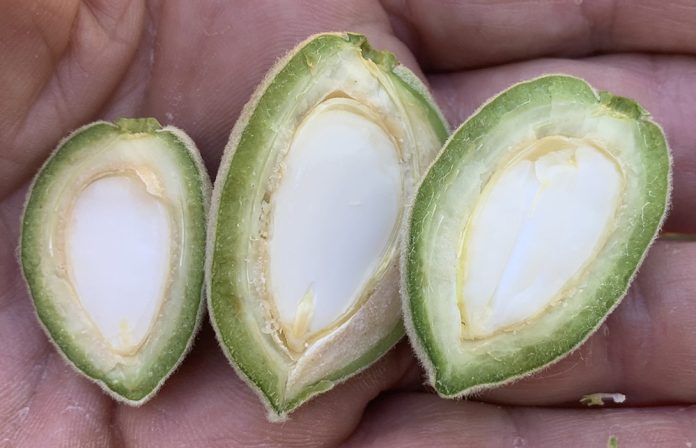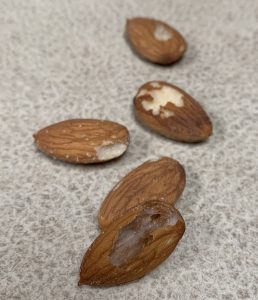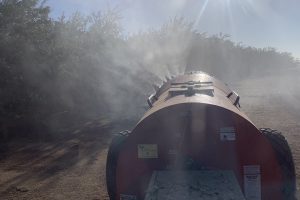
The crop and season are coming into focus. The main upside is water; a 100% surface water allocation following a wet, soil-cleansing winter. However, that wet winter rolled right through into spring, reducing the crop up and down the state. Mid-season, the yield per acre for the state looks to be off 15% to 30% from the 2017-21 crops. Many growers, especially in the north, are dealing with a spotty 2023 crop and low to very low budgets following the freeze year of 2022 and must be especially careful feeding and protecting this crop while maintaining bloom potential for next year. The following are some points for consideration as summer settles in.
Overall Strategy
2023 is a later-than-normal crop development year. With variable nut set in different orchards and varieties due to bloom conditions, income potential may be very different between orchards under the same management compared to earlier years. More resources could go to the orchards with more value potential (e.g., an orchard with good set and inshell potential) compared with an orchard with light Nonpareil set and heavy pollinizer set. Most growers and PCAs are probably already considering this overall approach.
Irrigation
Good, clean surface water is available this year. That’s a huge boost over last year. Delivering adequate but not excessive irrigation water is as important as ever. The pressure chamber is the gold standard for tracking orchard water status. Soil moisture sensor data are also effective in scheduling irrigation as is crop water use estimation, or evapotranspiration (ET). The key is to have a plan, monitor carefully and spot check with other tools to stay on track. In almond growing, there is no more important practice/activity than careful irrigation.
Due to concerns regarding possible hull rot and navel orangeworm damage, 2023 could be a good year to use strategic deficit irrigation (SDI) during hull split. This is best done using the pressure chamber to achieve -14 to -18 bars (average -15 bars is the target level) by 1% hull split, holding that stress for two weeks with careful irrigation and monitoring, and then returning the orchard to full ET until harvest cut-off. Valuable where needed, SDI is not beneficial for all orchards. For example, in a water-stressed orchard, even just slightly stressed so symptoms are invisible, cutting back irrigation can reduce yield. On the other hand, moderate, targeted water stress through SDI can help manage harvest and hull rot where needed such as vigorous, well fed and watered varieties on hybrid rootstock. See the very informative articles by David Doll (thealmonddoctor.com) on summer irrigation and regulated deficit irrigation in the links at the end of the article.

Pests
Delivering a quality crop with the best possible net return is challenging in a year with low prices and variable production (like this year.) Here are some thoughts as summer officially approaches.
Ant damage is an invisible income reducer. Ants mine the kernel meat as the nuts are drying on the orchard floor, making the kernels so light they are blown out at pickup. Monitor and treat for protein-feeding ants (fire ants and pavement ants) where found. Ant baiting is a very cost-effective practice. For best results with ant baits, only use fresh bait, spread on dry soil, don’t irrigate for 24 hours after spreading and manage spurge plants whose seeds appear like ant bait grains. Application timings for ant bait vary from eight weeks prior to harvest based on active ingredients. Check with your PCA about materials and timings. Note: Timely harvest nuts that need more drying time on the orchard floor are more vulnerable to ant damage. Good ant management is needed under those conditions so that reduced NOW damage (timely harvest) is not replaced by ant damage (more time on the orchard floor).

Monitoring for spider mites and beneficial mites/insects is key to avoiding mite flareups and defoliation at harvest. Integrated mite management is a bright spot in almond pest management as softer insecticides for worm control allow beneficial mites/insects to help control spider mites. If mite populations exceed economic thresholds, it is recommended to use materials that preserve, as much as possible, beneficial insects. Beneficial insects can be a backstop for mite control if selective miticides are used that don’t harm the beneficials. See the links for monitoring guidelines and beneficial insect vulnerabilities to pesticides.
Late-season (June to July) bug damage due to stink bug feeding is increasingly a concern in the industry. The damaged nuts don’t drop, but sunken brown spots on the nut surface result in off grade. Most of this damage is believed to be caused by green stink bugs and/or brown marmorated stink bugs (BMSB). Monitoring tools are limited, so regular observations in the orchard are important to limit damage when the pest is present. Stink bug feeding is localized in the tree as the insects are not highly mobile. Stink bug feeding appears as multiple, gumming “stings” per nut compared to one to two stings common with LFB feeding (leaf footed bug activity is more common in March to May.) Cut gumming nuts to see if a single pinhole feeding point is the gumming source, suggesting stink bug feeding. Check with your PCA regarding effective pesticides, rates and timings. See updated, detailed information on BMSB and how to differentiate between bugs in the links at the end of the article.
With costs up and returns down, this is a particular year to focus on “free” practices such as timely harvesting to help manage NOW (nuts on the orchard floor are much less likely to be located by female NOW looking to lay eggs.) Growers must balance inshell market potential, NOW pressure and risk of ant damage when timing harvest.
n using insecticides for NOW control, here are a few important points. Spray early rather than late for best control with the first spray, especially with the longer residual materials such as Intrepid® or Altacor®. Edge sprays (spraying into the orchard with just one side of the sprayer “on”) can help reduce early infestation and save money as the end/edge trees often split a week or so ahead of the rest of the orchard. If the later pollinizers have a heavy set in a certain orchard, a pollinizer spray right after Nonpareil pickup may help reduce NOW damage in the pollinizers and overall returns in the orchard. PHIs are important to consider in making this decision (harvest is when the nuts are shaken, not pickup.) Finally, a careful spray with good coverage throughout the orchard will deliver the best results possible. In multiple studies, more water (200 gallons/acre vs 100 gallons/acre) delivers better spray coverage and NOW control when the sprayer travels slowly (2 to 2.25 MPH). If the sprayer travels too fast for the size of the trees, the spray volume doesn’t matter; the pesticide won’t reach all the canopy.
Summer diseases such as rust, scab, Alternaria and hull rot can be significant problems depending on the summer weather. Alternaria is usually only a problem in certain microclimates with high relative humidity and temperatures from dusk through early morning. With the increase in rice acreage in the Sacramento Valley, humidity levels may be up this summer, and with them Alternaria pressure. Carmel, Sonora, Monterey, Winters, Butte and, in my experience, Independence, are varieties most susceptible to Alternaria.
In orchards with a history of Rhizopus hull rot, a fungicide spray containing a FRAC 3, 7, 11 and/or 19 fungicide reduces hull rot strikes compared to unsprayed trees. An equally effective hull rot control practice results from spraying alkaline foliar fertilizers such as di-potassium phosphate. There is no additional benefit in hull rot control from tank mixing these fertilizers with registered fungicides. Consult with your PCA regarding the best approach for your orchard/s. Hull rot fungicides are also generally very effective on summer diseases (rust, scab, alternaria).
Nutrition
Mature orchard nitrogen and potassium needs are largely driven by crop demand. By early to mid-June, even in a late year such as this, N demand should be fading. The orchard requires 30% of the total crop N budget between the end of kernel fill (roughly the last week of May this year?) and the end of kernel weight gain. Working with their CCA, growers will need to decide how much N is needed to finish the preharvest applications without blowing up hull rot. An early June leaf sample may help with the decision. See details on N management in almonds in the Almond Board of California publication referenced at the end of this article.
K use by an orchard is also driven by nut demand. Unlike N, K use continues at a steady rate through July in a normal year and maybe into early August this year. Potassium fertilizer is expensive, but K deficiency (July leaf K < 1%) this year can mean increased spur death this fall/winter, reduced flowers next spring, and reduced yield at harvest in 2024. It is too late to increase spur health once July leaf sample results are in, but early June leaf samples can show if K fertilization is needed to avoid less-than-adequate or deficient orchard K levels later in the summer. A low June leaf K sample result could signal the need for a small rate of K fertilizer (e.g., 50 lbs K2O/acre) to keep the orchard above the adequate threshold for July leaf sampling while limiting fertilizer K costs this year.
Make plans for leaf sampling in July and hull sampling for boron at harvest. Include sodium and chloride in the analysis request to help track these damaging salts.
The 2022 Almond Acreage Report from the National Ag Statistical Service was released in late April. It provides an interesting view of the recent planting trends in an industry with 1.37 million acres of bearing trees. In the last three years, almost 80% of all non-bearing trees, based on self-reported data, are planted to four varieties: Nonpareil (29%), Independence (23%), Monterey (16%) and Shasta (10%). Nonpareil, Independence and Monterey have been the “Big 3” since 2015, while Shasta is a newcomer to this list. Butte (5%), Padre (4%) and Aldrich (4%) make up another 12% to 13% of the non-bearing acres. All other varieties including such long-time standards as Fritz and Carmel are each planted at ≤ 2% of the total.
Finally, looking to harvest, fuel loads are up in the forests and woodlands following the wet winter/spring. Smoke from early wildfires could delay nut drying and pickup, leaving more time for NOW and ants to damage the crop and delay harvest of later varieties, which could produce more orchard stress in certain blocks. Growers and PCAs might consider planning for practices to accelerate nut drying and pickup (e.g., windrow conditioning) and carefully control NOW and ants as needed.
Best wishes for a good summer with warm (but not too hot) temperatures and no wildfires.
Resources
Irrigation
UC ANR Pressure chamber use in almonds, walnuts, and prunes (27 pages) anrcatalog.ucanr.edu/Details.aspx?itemNo=8503
The Almond Doctor on summer irrigation (blog post)
thealmonddoctor.com/irrigating-almonds-through-the-summer/
The Almond Doctor on Strategic Deficit Irrigation (SDI)
thealmonddoctor.com/regulated-deficit-irrigation-application/
Pests
UC IPM Ant management/monitoring
ipm.ucanr.edu/agriculture/almond/ants/
UC IPM Spider mite management/monitoring
ipm.ucanr.edu/agriculture/almond/webspinning-spider-mites/
UC IPM Relative Toxicity of pesticides used in almonds to natural enemies and honey bees
ipm.ucanr.edu/agriculture/almond/relative-toxicities-of-pesticides-used-in-almonds-to-natural-enemies-and-honey-bees/
UC IPM stink bug management/monitoring
ipm.ucanr.edu/agriculture/almond/stink-bugs/
UC IPM Brown marmorated stink bug management, including damage differences between bugs
ipm.ucanr.edu/PMG/r3303211.html
UC IPM Fungicide Efficacy and Timing publication
ipm.ucanr.edu/legacy_assets/pdf/pmg/fungicideefficacytiming.pdf
When do you shake almonds? UCCE Sac Valley Orchard blog
sacvalleyorchards.com/blog/almonds-blog/when-do-you-shake/
UC IPM Navel orangeworm management
ipm.ucanr.edu/agriculture/almond/navel-orangeworm/
Nutrients
Almond Board of California’s Nitrogen Best Management Practices
almonds.com/sites/default/files/2020-12/ABC_Nitrogen_8.5x11_vmags.pdf
Varieties/Planting Trends
National Ag Statistical Service’s 2022 Almond Acreage Planting Report
nass.usda.gov/Statistics_by_State/California/Publications/Specialty_and_Other_Releases/Almond/Acreage/202304almac.pdf










